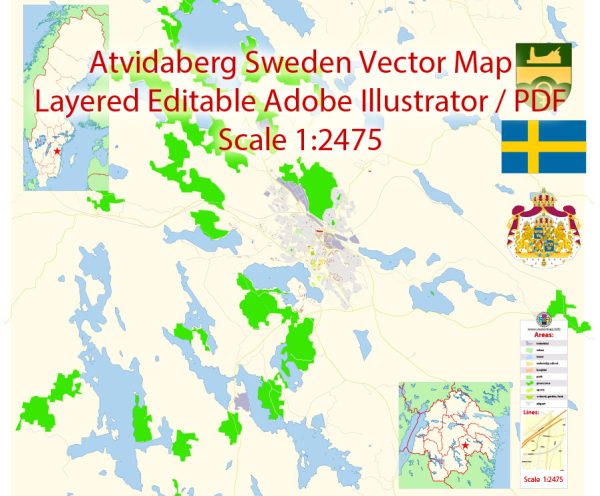Atvidaberg is a locality and the seat of Atvidaberg Municipality in the Östergötland County of Sweden. Historically, the economic development of Atvidaberg has been closely tied to its industrial activities, particularly mining and metallurgy.
Vectormap.Net provide you with the most accurate and up-to-date vector maps in Adobe Illustrator, PDF and other formats, designed for editing and printing. Please read the vector map descriptions carefully.
Here is a brief overview of the economic history of Atvidaberg:
1. Mining and Metallurgy (17th-19th centuries): Atvidaberg has a long history of mining and metallurgical activities, dating back to the 17th century. The area was known for its copper and iron mines, and the establishment of mining operations played a crucial role in shaping the local economy. The mining industry in Atvidaberg experienced significant growth during the 18th and 19th centuries, contributing to the region’s prosperity.
2. The Atvidaberg Company (19th-20th centuries): One of the most influential factors in Atvidaberg’s economic history was the establishment of the Atvidaberg Company (Atvidabergs Aktiebolag) in 1836. This company became a major player in the mining and metallurgical sectors, managing several mines and metalworks in the region. The Atvidaberg Company played a central role in the development of the local economy, providing employment and contributing to the growth of the town.
3. Industrialization and Diversification (Late 19th-20th centuries): The late 19th century witnessed the broader industrialization of Sweden, and Atvidaberg was no exception. The town saw diversification in its industrial base beyond mining and metallurgy. New industries emerged, contributing to job creation and economic expansion. The Atvidaberg Company continued to evolve, adapting to changing economic conditions.
4. Decline of Traditional Industries (Late 20th century): Like many industrial regions, Atvidaberg faced challenges in the latter half of the 20th century. The decline of traditional industries, including mining and metallurgy, had economic repercussions. Changes in global markets, technological advancements, and shifts in demand for certain products contributed to the challenges faced by the local economy.
5. Economic Transition and Modernization (Late 20th century-present): In response to the decline in traditional industries, Atvidaberg, like many Swedish municipalities, underwent a process of economic transition and modernization. Efforts were made to diversify the local economy, attract new industries, and invest in education and infrastructure. The town sought to position itself for the challenges of the 21st century, focusing on areas such as technology, services, and sustainable development.
6. Contemporary Economic Landscape: As of my last knowledge update in January 2022, specific details about the contemporary economic landscape of Atvidaberg might not be available. However, the trajectory likely involves ongoing efforts to adapt to global economic trends, promote innovation, and ensure the sustainability of the local economy.
It’s important to note that economic histories are dynamic, and changes may have occurred since my last update. For the most recent and detailed information, consulting local historical records, economic reports, or contacting relevant authorities in Atvidaberg would be recommended.


 Author: Kirill Shrayber, Ph.D.
Author: Kirill Shrayber, Ph.D.